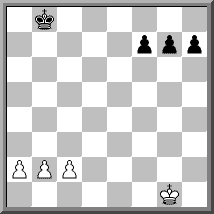In chess, symmetry normally refers to a position which is symmetrical along the horizontal mid-axis (mirrored along the 4th and 5th rank). This probably is because it's the kind of symmetry which occurs most frequently and therefore is of most practical interest.
However, it is also possible to reach positions which are symmetrical along the long diagonals.
This pawn endgame for a period was a popular wild variant on ICC:

It is completely solvable and reminds of the ancient game of Nim which has long been mathematically solved (at least the most popular versions).
I have heard rumors that this game was removed from the server because it attracted gambling. If that's correct it's strange because it's a game that in principle can be mastered completely and doesn't involve any element of chance.
That of course doesn't stop it being a devilishly difficult game to play perfectly. I assume most of those playing it for big sums of money must have had access to tables with computer generated solutions.
For a beginning understanding it may be useful to analyze this position which obviously is closely related to the initial position:
 My guess is that White to move loses. But although I analyzed this position (or a similar one with kings on b7 and g2) 25 years ago I must admit that I don't remember anything about it - except that it isn't a draw.
My guess is that White to move loses. But although I analyzed this position (or a similar one with kings on b7 and g2) 25 years ago I must admit that I don't remember anything about it - except that it isn't a draw.Preliminary conclusion: Diagonal symmetry occurs relatively rarely in practical chess and tends to lead to races and occasional zugzwang and not to drawish positions.
In future entries I will concentrate on symmetry along the horizontal mid-line.
PS: Today I added a chess gadget to my blog. You can see it at the bottom of the main window. I have no idea how good, hard or varied the exercizes are. It seems you get a new diagram every time you reload the page [F5].
No comments:
Post a Comment